Precision Farming Market Size
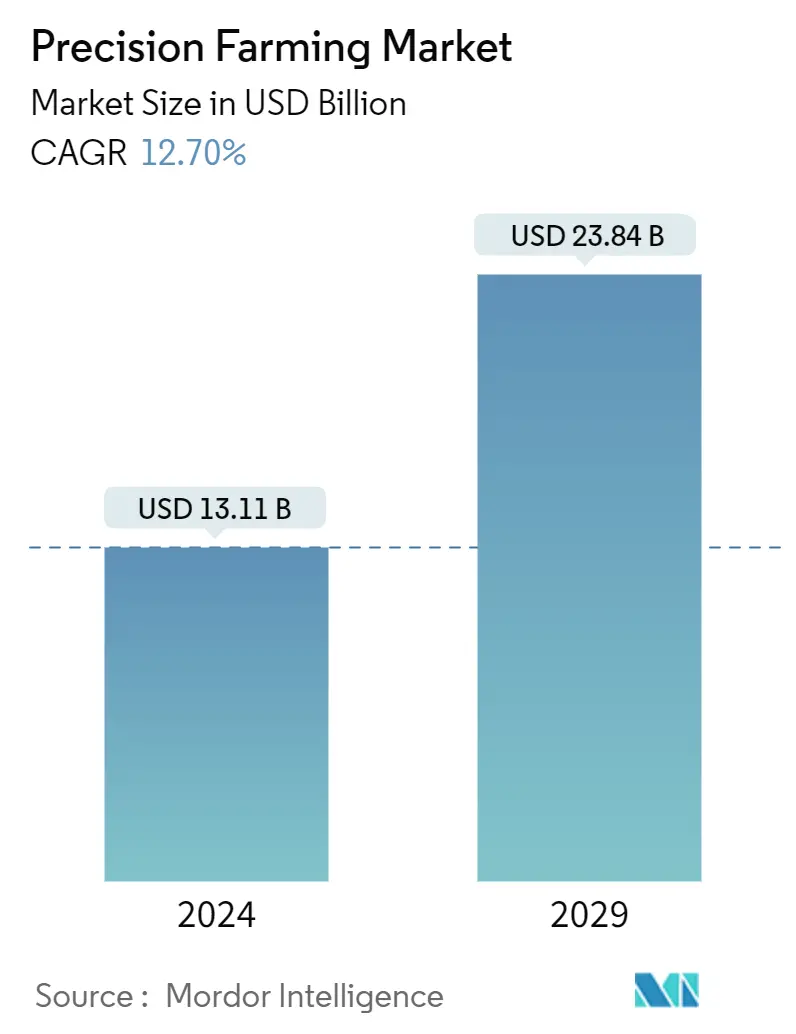
| Study Period | 2019 - 2029 |
| Market Size (2024) | USD 13.11 Billion |
| Market Size (2029) | USD 23.84 Billion |
| CAGR (2024 - 2029) | 12.70 % |
| Fastest Growing Market | Asia Pacific |
| Largest Market | North America |
Major Players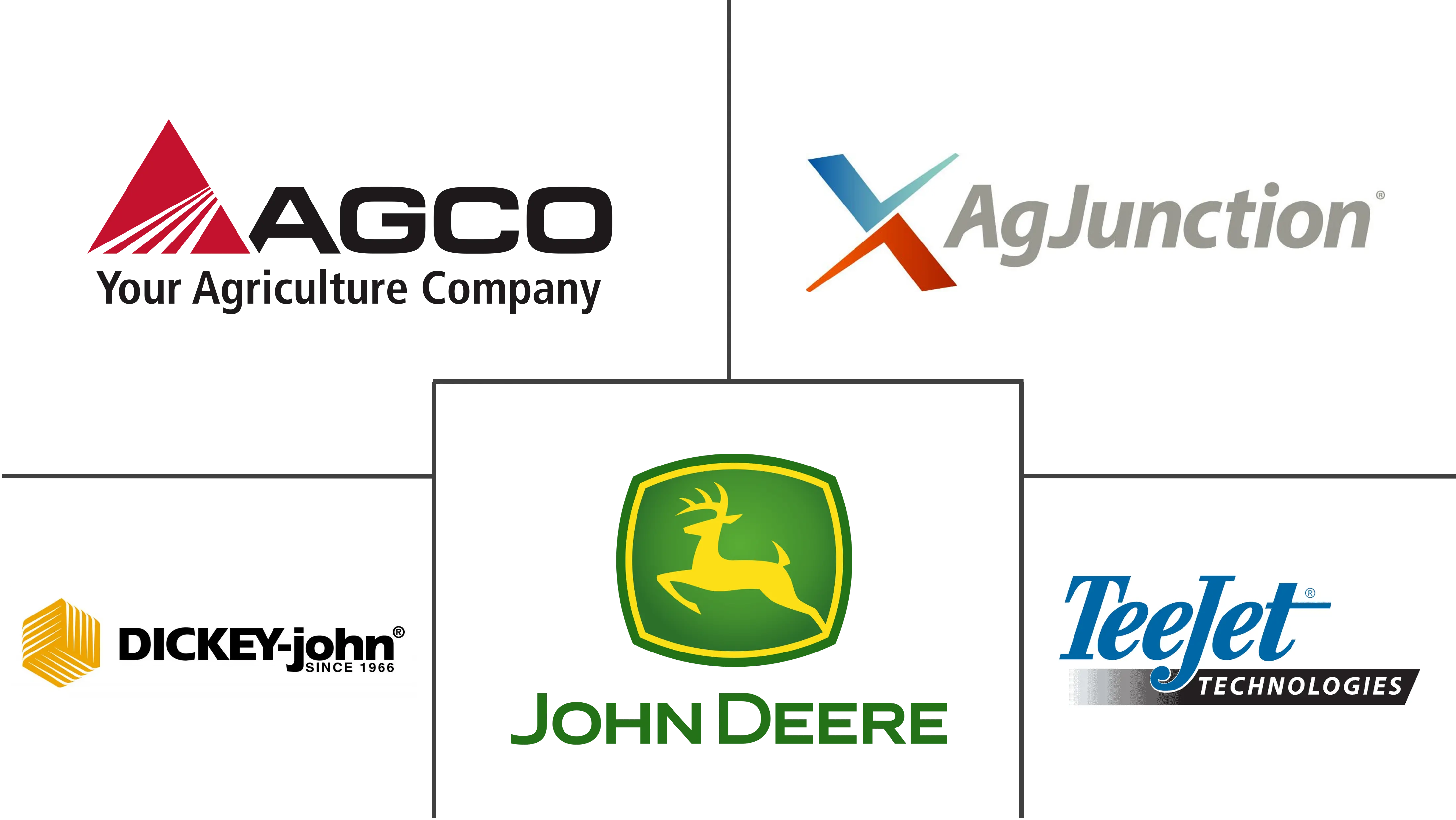
*Disclaimer: Major Players sorted in no particular order |
Precision Farming Market Analysis
The Precision Farming Market size is estimated at USD 13.11 billion in 2024, and is expected to reach USD 23.84 billion by 2029, growing at a CAGR of 12.70% during the forecast period (2024-2029).
Some of the main drivers for adopting precision farming are climate change, growing demand for food, more technology adoption in global agriculture sector and government initiatives to improve farmers' efficiency by means of new technologies.
- Precision farming is an agricultural management concept which focuses on the observation, measurement and response to crop variability between fields. Production of plants is focused on the areas defined by property lines, expected crop yields in a given field and geographical and environmental factors.
- Moroever, Precision farming, which will overtake other advances in agriculture by the end of 2030, is predicted to be an important trend. Through the mobile app, real time information on equipment is available through remote sensing and ground communication. (VRTs) has allows farmers to make more specific land management decisions, so that inputs like seeds, fertilisers and pesticides can be used more effectively in the context of changing weather conditions.
- Most broad-market vendors offer guidance systems, climate-weather predictions, and input applications equipment. Small vendors mainly target smart irrigation and field monitoring techniques specializing in IoT solutions. North America is the early adopter of technology and has a significant adoption rate of many innovative technologies used in precision farming. The region is a substantial adopter of IoT, big data, drones, and robotics in agriculture.
- Moreover, growing investments in technologies such as driverless tractors, guidance systems, and GPS sensing systems are also anticipated to contribute to the precision agriculture market scope growth during the study period.
- High costs have made it tough for small-scale farmers to deploy the tools, thereby, restricting them to only large farms. However, variable rate application (VRA) and controlled traffic systems (CTF) help in enhanced utilization of crop nutrients, improvement of crop quality, and the reduction of overlap, thus resulting in better production economy.
- However, more significant adoption could result from deploying remote sensing and farm management software technologies after COVID-19. Businesses have already started concentrating more on wireless platforms to support real-time decision-making for crop health monitoring, yield monitoring, irrigation scheduling, field mapping, and harvesting management. This may propel the studied market demand in the forecasted period.
Precision Farming Market Trends
Soil Monitoring is Expected to Hold Significant Share
- By means of reliable communication, soil sensors are capable of measuring the essential properties of soils and transmitting them to a display unit. In order to create field maps based on the soil's characteristics, soils sensors are usually used in combination with velocity applications or GPS. Soil sensors are essential for monitoring the viability of crop growth at harvest time.
- After analysing the data, sensors provide real time information which changes the application rate accordingly. It is considered that traditional models of using the map approach are more efficient. In the following steps, they enable a problem analysis to be carried out and variable rate applications to be adapted.The various type of sensors being integrated for soil monitoring purposes includes electromagnetic, optical, mechanical, acoustic, and electrochemical, as far as industrial research has reached.
- Moreover, in view of the increasing use of different soil monitoring sensors by forward thinking farmers from around the world, ground surveillance systems are expected to be a major demand throughout the forecast period. The market share of ground monitoring is high because it does not require a lot of expertise. Improvements in intelligent sensor technologies and their integration with the Internet of Things modules have led to a growing demand for integrated agriculture.
- Furthermore, technological advancement in farming may further propel the studied market growth. According to ETNO, the number of IoT active connections in agriculture was expected to increase in the European Union through the years. It was recorded at 46.92 million connections in 2022 and is expected to reach 70.26 million by 2025. Some uses for IoT devices in agriculture would be drone usage for surveillance or distributing seeds.
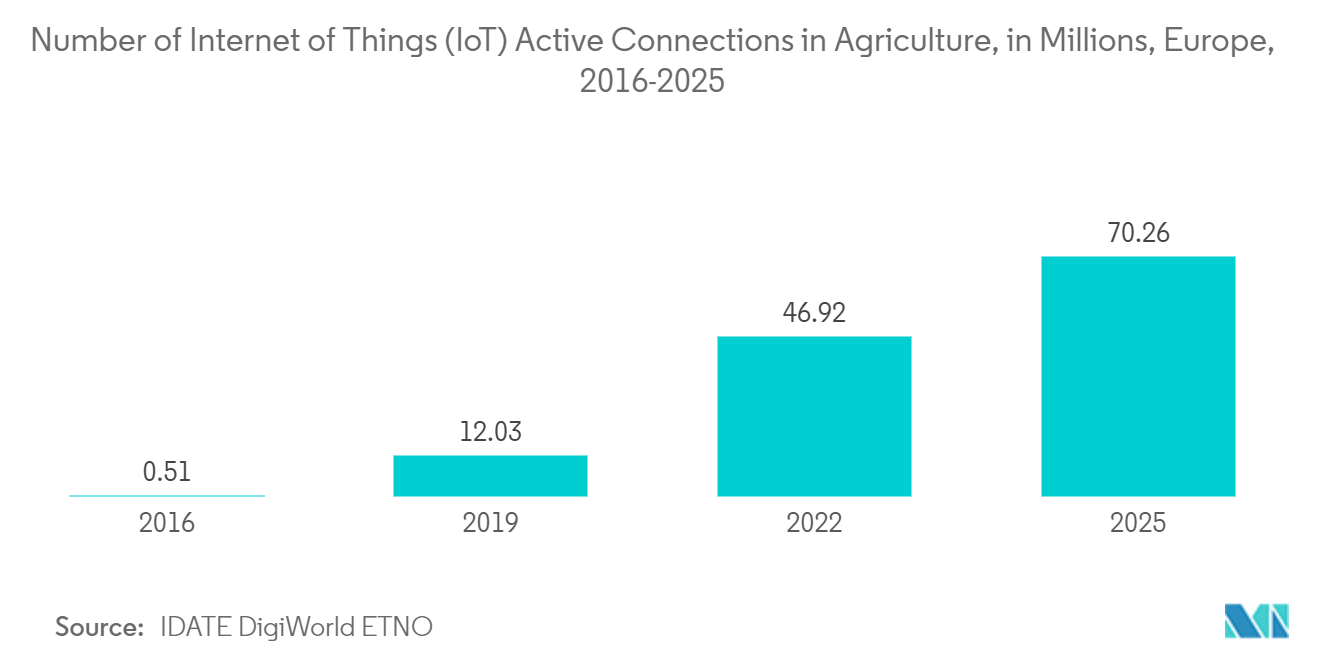
Asia-Pacific to Experience Significant Market Growth
- In particular due to government initiatives in developing countries encouraging the use of modern precision farming technologies, which is aimed at maximising productivity, this region is expected to experience significant growth over the projected period.
- According to IBEF, from INR 1,931,288.7 crore USD 263 billion last month on the back of government initiatives like Pradhan Mantri Kisan Sampada Yojana and plans for a 1 trillion dollar infrastructure, India's processing food market is projected to increase to INR 3,451,352.5 cr USD 470 billion by 2025.
- In many Asian countries, service providers are rapidly moving to improve their application methods and make Asia agriculture the main focus of study market vendors. Smart tractors, UAVs, ground leveling services, pesticide application, satellite imaging, irrigation services, and handheld decision diagnostics along with In this region, without investment in costly infrastructure, decision support is becoming more easily available for small farmers.
- The market growth is being driven by some of the main factors in Asia-Pacific are augmented yield and profitability, which are pushing farmers toward crop monitoring technology in precision farming.
- Australia holds the major share of market in this region. The market is yet to catch up with its growing demand for food crops and the anticipated growth in the variable rate applications (VRA) market. Some of the opportunities in the region are application of drones and unmanned aerial vehicles (UAVs) in precision farming practices and the growing environmental issues.
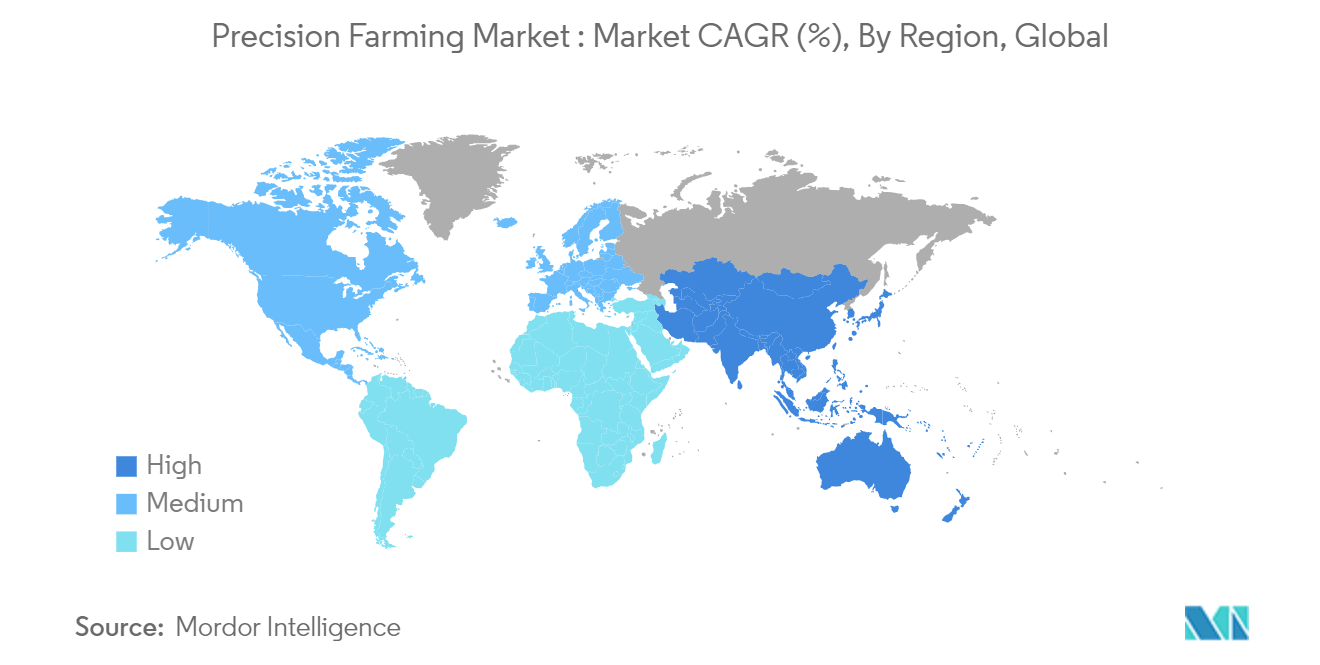
Precision Farming Industry Overview
The precision farming market is highly fragmented, with numerous participants involved. Key players in the market include AgJunction Inc., Raven Industries Inc., DICKEY-john Corporation., TeeJet Technologies., and others. These companies are engaged in market expansion activities and adopting organic and inorganic growth strategies to maximize their revenue across different regions.
- In October 2023, Deere & Co teams with 2 Sweden-based Delaval on the Milk Sustainability Center and Norway-based Yara on digital precision agriculture tools for sustainability, where the partnerships aim to help farmers track livestock and fertilizer data so they can make smarter business decisions that are better for the environment.
- In April 2023 AGCO Corporation, a one of global agriculture equipment provider, and Hexagon, an industrial technology solution provider declared their strategic collaboration. The collaboration is focused on the expansion of AGCO’s factory-fit and aftermarket guidance offerings.
Precision Farming Market Leaders
-
AGCO Corporation
-
Ag Junction Inc
-
John Deere
-
DICKEY-john Corporation
-
TeeJet Technologies
*Disclaimer: Major Players sorted in no particular order
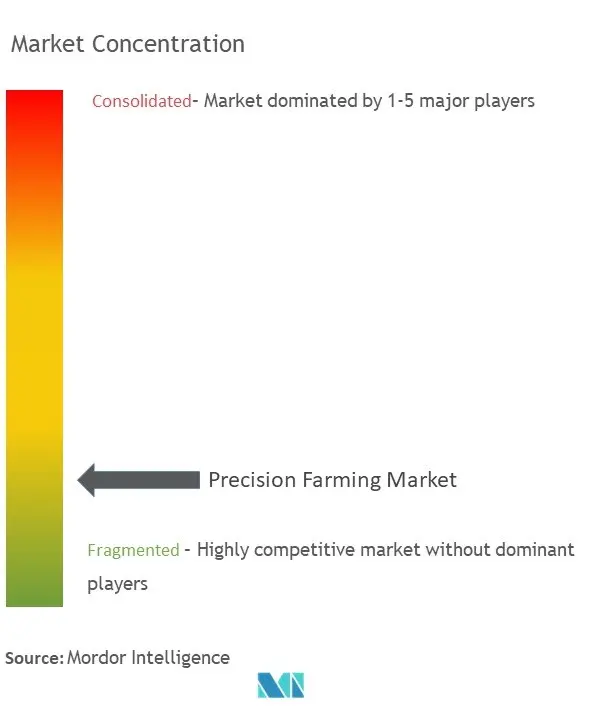
Precision Farming Market News
- In July 2023, The acquisition of Smart Apply Inc., a provider of agricultural technology solutions, has been announced by Deere & Company, In order to assist farmers in dealing with the challenges of regulatory requirements, input costs, labour etc., Deere & Company is focusing on using Smart ApplyTM precision spraying solutions. The acquisition is intended to boost the company's new customer base.
- In May 2023, AgEagle Aerial Systems Inc., one of global agriculture technology solution provider announced its establishment of a new supply agreement with Wingtra AG. The 2-year supply agreement is expected to securely supply RedEdge-P sensor kits for incorporation with WingtraOne VTOL drones.
- In February 2023, Murata, in collaboration with longstanding systems integration partner Sentinum, announced the GAIA soil monitoring solution, which, according to the company, could have a crucial role to play in smart agriculture. These soil sensors help maximize crop yields while decreasing fertilizer use and minimizing the amount of water needed for irrigation.
Precision Farming Market Report - Table of Contents
1. INTRODUCTION
- 1.1 Study Assumptions and Market Definition
- 1.2 Scope of the Study
2. RESEARCH METHODOLOGY
3. EXECUTIVE SUMMARY
4. MARKET INSIGHTS
- 4.1 Market Overview
-
4.2 Industry Attractiveness- Porter's Five Forces Analysis
- 4.2.1 Bargaining Power of Buyers
- 4.2.2 Bargaining Power of Suppliers
- 4.2.3 Threat of New Entrants
- 4.2.4 Threat of Substitute Products
- 4.2.5 Intensity of Competitive Rivalry
- 4.3 Assessment Of COVID-19 Impact On The Industry
5. MARKET DYNAMICS
-
5.1 Market Drivers
- 5.1.1 Soil Monitoring using AI and IOT technologies to drive the market
- 5.1.2 Emergence of New Technologies
- 5.1.3 Government Initiative and Increasing Number of Startups
-
5.2 Market Challenges
- 5.2.1 Difference in Awareness in Different Regions is also Resulting in Varying Adoption Patterns in These Regions
-
5.3 Market Opportunities
- 5.3.1 Technological Advancement is Reducing the Cost of Many Advance Equipment
- 5.3.2 Advancement in Technologies, like LIDAR-enabled Drones, and Emergence of Data Analytics and Cloud in the Sector
6. MARKET SEGMENTATION
-
6.1 By Technology
- 6.1.1 Guidance System
- 6.1.1.1 Global Positioning System (GPS)/ Global Satellite Navigation System (GNSS)
- 6.1.1.2 Global Information System (GIS)
- 6.1.2 Remote Sensing
- 6.1.3 Variable-rate Technology
- 6.1.3.1 Variable Rate Fertilizer
- 6.1.3.2 Variable Rate Seeding
- 6.1.3.3 Variable Rate Pesticide
- 6.1.4 Drones and UAVs
- 6.1.5 Other Technologies
-
6.2 By Component
- 6.2.1 Hardware
- 6.2.2 Software
- 6.2.3 Services
-
6.3 By Application
- 6.3.1 Yield Monitoring
- 6.3.2 Variable Rate Application
- 6.3.3 Field Mapping
- 6.3.4 Soil Monitoring
- 6.3.5 Crop Scouting
- 6.3.6 Other Applications
-
6.4 By Geography
- 6.4.1 North America
- 6.4.1.1 United States
- 6.4.1.2 Canada
- 6.4.2 Europe
- 6.4.2.1 Germany
- 6.4.2.2 United Kingdom
- 6.4.2.3 France
- 6.4.2.4 Rest of Europe
- 6.4.3 Asia-Pacific
- 6.4.3.1 China
- 6.4.3.2 Japan
- 6.4.3.3 India
- 6.4.3.4 Australia
- 6.4.3.5 Rest of the Asia-Pacific
- 6.4.4 Latin America
- 6.4.5 Middle East & Africa
7. COMPETITIVE LANDSCAPE
-
7.1 Company Profiles
- 7.1.1 AGCO Corporation
- 7.1.2 Ag Junction Inc
- 7.1.3 John Deere
- 7.1.4 DICKEY-john Corporation
- 7.1.5 TeeJet Technologies
- 7.1.6 Raven Industries Inc.
- 7.1.7 Lindsay Corporation
- 7.1.8 Topcon Precision Agriculture
- 7.1.9 Land O'lakes Inc.
- 7.1.10 BASF SE
- 7.1.11 Yara International ASA
- *List Not Exhaustive
8. INVESTMENT ANALYSIS
9. FUTURE OF THE MARKET
** Subject To AvailablityPrecision Farming Industry Segmentation
Precision farming (PF) is the approach of farm management that brings in information technology IT to ensure that the crops and soil get what they need for health and productivity. The goal of PA is to guarantee profitability, sustainability, and protection of the environment. PA is also recognized as satellite agriculture, as-needed farming, and site-specific crop management (SSCM).
The precision agriculture market is segmented by technology (guidance systems, remote sensing, variable-rate technology, drones, and UAVs), component (hardware, software, services), application (yield monitoring, variable rate application, field mapping, soil monitoring, crop scouting), and geography (North America (United States, Canada), Europe (Germany, United Kingdom, France, Rest of Europe), Asia-Pacific (China, Japan, India, Australia, Rest of the Asia-Pacific), Latin America, Middle East & Africa). The market sizes and forecasts are provided in terms of value (USD) for all the above segments.
| By Technology | Guidance System | Global Positioning System (GPS)/ Global Satellite Navigation System (GNSS) |
| Global Information System (GIS) | ||
| By Technology | Remote Sensing | |
| Variable-rate Technology | Variable Rate Fertilizer | |
| Variable Rate Seeding | ||
| Variable Rate Pesticide | ||
| Drones and UAVs | ||
| Other Technologies | ||
| By Component | Hardware | |
| Software | ||
| Services | ||
| By Application | Yield Monitoring | |
| Variable Rate Application | ||
| Field Mapping | ||
| Soil Monitoring | ||
| Crop Scouting | ||
| Other Applications | ||
| By Geography | North America | United States |
| Canada | ||
| By Geography | Europe | Germany |
| United Kingdom | ||
| France | ||
| Rest of Europe | ||
| By Geography | Asia-Pacific | China |
| Japan | ||
| India | ||
| Australia | ||
| Rest of the Asia-Pacific | ||
| By Geography | Latin America | |
| Middle East & Africa |
Precision Farming Market Research FAQs
How big is the Precision Farming Market?
The Precision Farming Market size is expected to reach USD 13.11 billion in 2024 and grow at a CAGR of 12.70% to reach USD 23.84 billion by 2029.
What is the current Precision Farming Market size?
In 2024, the Precision Farming Market size is expected to reach USD 13.11 billion.
Who are the key players in Precision Farming Market?
AGCO Corporation, Ag Junction Inc, John Deere, DICKEY-john Corporation and TeeJet Technologies are the major companies operating in the Precision Farming Market.
Which is the fastest growing region in Precision Farming Market?
Asia Pacific is estimated to grow at the highest CAGR over the forecast period (2024-2029).
Which region has the biggest share in Precision Farming Market?
In 2024, the North America accounts for the largest market share in Precision Farming Market.
What years does this Precision Farming Market cover, and what was the market size in 2023?
In 2023, the Precision Farming Market size was estimated at USD 11.45 billion. The report covers the Precision Farming Market historical market size for years: 2019, 2020, 2021, 2022 and 2023. The report also forecasts the Precision Farming Market size for years: 2024, 2025, 2026, 2027, 2028 and 2029.
What are the key technologies driving the growth of Precision Farming?
The key technologies driving the growth of Precision Farming are a) Drones b) Agricultural robots c) Sensors d) Farm management software
Precision Farming Industry Report
The Precision Farming Market is witnessing remarkable growth, fueled by the integration of advanced technologies like Internet of Things (IoT), GPS, and remote sensing, revolutionizing agricultural efficiency and crop management. This surge is propelled by the demand for sustainable agriculture, allowing for precise input application, thus minimizing environmental impact. The advent of digital agricultural platforms and farm management software is empowering farmers with data-driven decision-making tools, boosting productivity. Despite challenges such as internet connectivity and data privacy concerns, the market's trajectory is upward, due to the adoption of variable rate technology and significant opportunities in regions like Asia Pacific. The Precision Farming Market, set to redefine agriculture with precision and sustainability, is analyzed in detail by Mordor Intelligence™, offering insights into market share, size, and revenue growth. This analysis, highlighting the transformative potential of Precision Farming Technology, is available as a free report PDF download, providing a forecast outlook and historical overview of the Precision Farming Market Size and its impact on modern agriculture.



